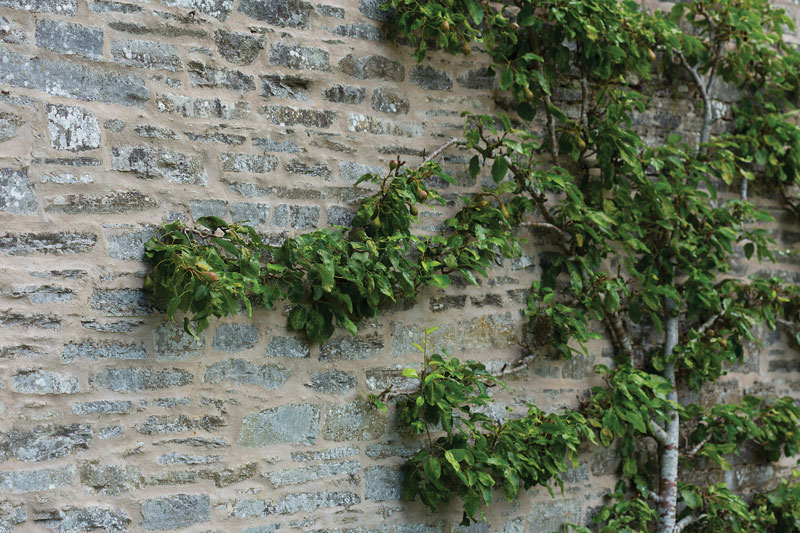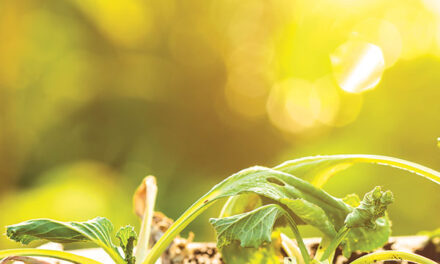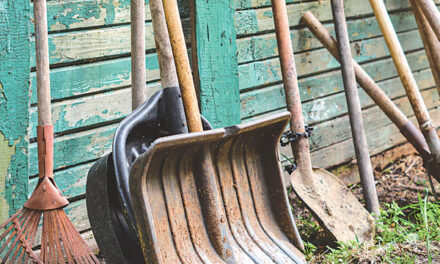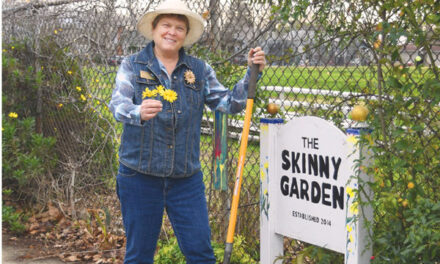The Art of Espalier
Master flat technique for fruitful, decorative gardening
By Anita Clevenger
October 2019
I began seeing espaliered plants long before I knew the word “espalier,” and certainly before I knew how to pronounce it (either es-pal-YAY or es-pal-YER is correct). However you say it, the practice of training woody plants, such as fruit trees or ornamental shrubs, flat against a wall or support can be decorative and interesting, produce more and better flowers and fruit, and allow you to grow otherwise too-large plants in a limited space.

The art of espalier is said to have begun in Roman times and perfected in medieval European gardens. It is still being used. I’ve seen espaliered plants in European orchards and historic or formal gardens in many parts of the world. In Switzerland, I was so intrigued by hundreds of espaliered apple trees that I made my husband stop the car so that I could examine and photograph them. Their neatly spread branches satisfied the Swiss need for order and ensured that fruit would ripen with as much sunlight as possible.
Pear trees are espaliered against the walls in the gardens at The Cloisters in New York City, adding to their air of antiquity. In the upper garden at Mount Vernon, espaliered fruit trees grow just as they did in George Washington’s time. At Descanso Gardens in Southern California, ornamental pear trees are grown in overlapping V-shapes to form a striking “Belgian Fence.”
You can espalier on a much less formal and ambitious scale. Inspired by a row of lemon trees that I saw trained next to a driveway in my neighborhood, I now grow an espaliered camellia tied onto trellises along my narrow side yard. At the Fair Oaks Horticulture Center, UC Master Gardeners have espaliered apple, Asian pear, peach, citrus, cherry and pomegranate trees, training tree shoots along wires or spreading them out in a fan shape while carefully selecting and maintaining fruiting spurs.
My favorite way to grow climbing roses is to espalier them against a wall or fence. Roses, like many plants, tend to grow straight up, producing flowers at the end of their canes. If you cut off the tips of canes and train them horizontally or at an angle, they will produce flowering lateral canes at growth buds all along their length. An espaliered rose is a great feature at the back of a planting bed or along a path. During the growing season, be sure to protect strong new canes. In the winter, cut out unproductive or damaged old canes, tie in new ones and cut back lateral growth to two or three buds.
You can buy trees or shrubs already trained as an espalier but you can’t just plant and forget them. Espaliered plants aren’t exactly low-maintenance. You must have a pair of pruning shears and not be afraid to use them. Once you master the technique, you may begin viewing every wall and fence as an opportunity to espalier another plant.
Interested in becoming a Master Gardener? Applications are being accepted for the 2020 training class through Oct. 18. Visit sacmg.ucanr.edu/master_gardener_training.
The last Open Garden of the year will be Wednesday, Oct. 9, from 9 a.m.–noon at the Fair Oaks Horticulture Center, 11549 Fair Oaks Blvd. in Fair Oaks.
Anita Clevenger is a platinum Sacramento County Master Gardener. For answers to gardening questions, contact the UC Master Gardeners at (916) 876-5338 or mgsacramento@ucanr.edu, or visit sacmg.ucanr.edu. Follow us on Facebook, Twitter and Instagram: @insidesacramento.



















